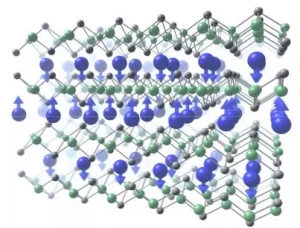
When photoexcited by an ultrafast laser pulse, antiferromagnets allow direct angular momentum transfer between opposing spins, promising faster functionality than ferromagnets, which are inherently limited because their net angular momentum must be dissipated into the lattice. The process of angular momentum transfer is closely related to the type of magnetic coupling in the system.
In lanthanides, magnetic 4f exchange is mediated indirectly via the conduction electrons (Ruderman-Kittel-Kasuya-Yosida interaction, RKKY), and the effects of such conditions on antiferromagnetic direct spin transfer are largely unexplored. The Ruderman-Kittel-Kasuya-Yosida interaction (RKKY interaction, after Malvin Avram Ruderman, Charles Kittel, Tadao Kasuya and Kei Yosida) describes the indirect exchange between the localised magnetic moments of the atoms of a metal. If an electron comes close to a magnetic atom, it aligns its spin with it. If the electron now moves further through the solid, the spin polarisation of the electron can in turn cause an alignment of the magnetic moment of one of the nearest atoms.
Here resonant ultrafast X-ray diffraction are utilized to study ultrafast magnetization dynamics in a series of 4f antiferromagnets, and systematically varied the 4f occupation, thereby altering the magnitude of RKKY. Combined with with ab-initio calculations, the researchers find that the rate of angular momentum transfer between opposing moments is directly determined by the magnitude of RKKY. Given the direct relationship between RKKY and the conduction electrons, the results offer a novel approach for controlling the speed of magnetic devices.